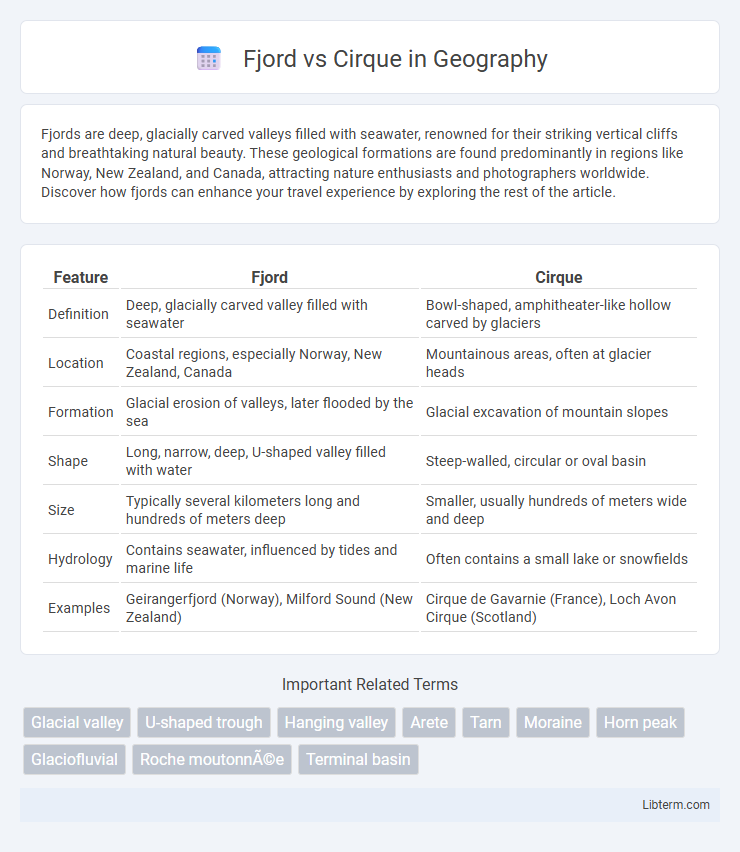Fjords are deep, glacially carved valleys filled with seawater, renowned for their striking vertical cliffs and breathtaking natural beauty. These geological formations are found predominantly in regions like Norway, New Zealand, and Canada, attracting nature enthusiasts and photographers worldwide. Discover how fjords can enhance your travel experience by exploring the rest of the article.
Table of Comparison
| Feature | Fjord | Cirque |
|---|---|---|
| Definition | Deep, glacially carved valley filled with seawater | Bowl-shaped, amphitheater-like hollow carved by glaciers |
| Location | Coastal regions, especially Norway, New Zealand, Canada | Mountainous areas, often at glacier heads |
| Formation | Glacial erosion of valleys, later flooded by the sea | Glacial excavation of mountain slopes |
| Shape | Long, narrow, deep, U-shaped valley filled with water | Steep-walled, circular or oval basin |
| Size | Typically several kilometers long and hundreds of meters deep | Smaller, usually hundreds of meters wide and deep |
| Hydrology | Contains seawater, influenced by tides and marine life | Often contains a small lake or snowfields |
| Examples | Geirangerfjord (Norway), Milford Sound (New Zealand) | Cirque de Gavarnie (France), Loch Avon Cirque (Scotland) |
Introduction to Fjords and Cirques
Fjords are deep, glacially carved coastal inlets characterized by steep cliffs formed from the retreat of glaciers, primarily found in regions like Norway, New Zealand, and Canada. Cirques are amphitheater-shaped depressions on mountainous terrain, created by glacial erosion at the head of a glacier, commonly located in alpine environments. Both fjords and cirques serve as key indicators of past glacial activity and distinct landscape evolution processes.
Geological Formation: Fjord vs Cirque
Fjords are deep, narrow inlets formed by glacial erosion, characterized by steep cliffs and U-shaped valleys submerged by seawater. Cirques are amphitheater-like hollows carved into mountainsides by glacial activity, typically marking the origin of glaciers and featuring steep headwalls with bowl-shaped depressions. Both landforms result from glacial processes but differ in scale and location, with fjords extending into ocean basins and cirques confined to high alpine environments.
Key Physical Characteristics
Fjords are deep, narrow inlets with steep sides or cliffs, carved by glacial activity and typically found along coastlines, characterized by their U-shaped cross-section and considerable depth. Cirques are amphitheater-like valleys formed by glacial erosion, marked by a bowl-shaped, steep-walled depression at the head of a glacier. While fjords connect to the sea and often contain seawater, cirques are usually isolated, freshwater depressions located in high mountainous regions.
Origins and Glacial Processes
Fjords and cirques both originate from glacial processes but differ in formation and scale. Fjords are deep, narrow inlets created when glaciers carve U-shaped valleys along coastlines, later flooded by rising sea levels. Cirques form as amphitheater-like, bowl-shaped depressions at the head of glaciers, sculpted through intensive plucking and abrasion during glacier erosion.
Examples of Famous Fjords
Fjords are deep, narrow inlets of the sea carved by glaciers, with notable examples including Norway's Sognefjord, New Zealand's Milford Sound, and Canada's Howe Sound, each showcasing steep cliffs and dramatic landscapes. Unlike cirques, which are bowl-shaped, amphitheater-like depressions formed at the heads of glacial valleys, fjords extend far inland and often serve as navigable waterways. Famous fjords attract millions of tourists annually due to their stunning natural beauty and significant ecological diversity.
Notable Cirques Around the World
Notable cirques around the world include the Cirque de Gavarnie in the French Pyrenees, famous for its dramatic amphitheater and towering waterfalls, and the Minaret Cirque in New Zealand's Southern Alps, renowned for its glacially carved basin surrounded by rugged peaks. Their distinctive bowl-shaped, steep-walled depressions are formed by glacial erosion, contrasting with fjords, which are deep, elongated sea inlets created by glacial activity and later flooded by seawater. Cirques serve as key indicators of past glaciation, helping geologists understand Earth's climatic history and the dynamics of mountain glaciation.
Ecological Differences
Fjords, formed by glacial erosion and characterized by deep, saltwater-filled valleys, support diverse marine ecosystems with species adapted to cold, nutrient-rich waters such as krill, salmon, and seals. Cirques, being amphitheater-like hollows carved into mountains by glaciers, host unique alpine ecosystems with specialized flora like mosses, lichens, and hardy shrubs adapted to colder air and freshwater conditions. The ecological differences stem from their distinct hydrological environments--marine versus freshwater--and varying temperature and nutrient availability influencing species diversity and adaptation.
Human Activities and Tourism
Fjords attract a significant number of tourists due to their deep, glacially carved valleys filled with seawater, offering activities like kayaking, boat tours, and fishing, which boost local economies. Cirques, characterized by bowl-shaped depressions formed by glacial erosion, are popular among hikers and climbers seeking challenging terrains and scenic viewpoints. Both geological features support eco-tourism and outdoor recreation, with fjords providing marine-based experiences while cirques offer mountainous adventures.
Significance in Climate and Geography
Fjords, deep glacially carved valleys flooded by seawater, play a crucial role in regulating coastal marine ecosystems and carbon sequestration due to their unique water circulation and sedimentation patterns. Cirques, bowl-shaped depressions formed by glacial erosion in mountainous regions, serve as indicators of past and present climate conditions through their impact on snow accumulation and glacier formation. Both landforms provide valuable geological records essential for understanding climate change and glacial dynamics in diverse geographic settings.
Summary: Comparing Fjords and Cirques
Fjords and cirques are distinct glacial landforms shaped by ice erosion, with fjords being deep, narrow sea inlets formed by submerged glacial valleys, and cirques as amphitheater-like hollows found at the head of glaciers. Fjords often feature steep cliffs and extend below sea level, creating unique marine ecosystems, whereas cirques are characterized by steep-walled basins that collect snow and glacier ice. The primary difference lies in their formation environment: fjords are coastal and filled with seawater, while cirques are mountainous, fresh water features formed by glacier accumulation.
Fjord Infographic

 libterm.com
libterm.com